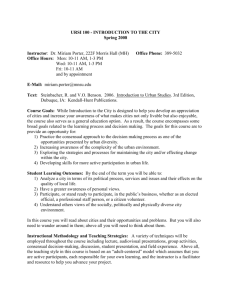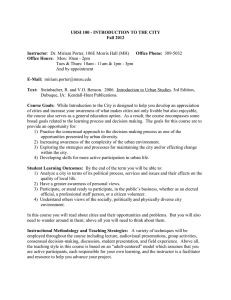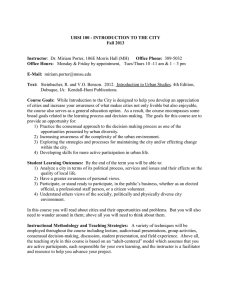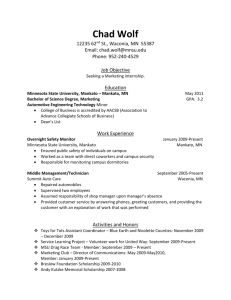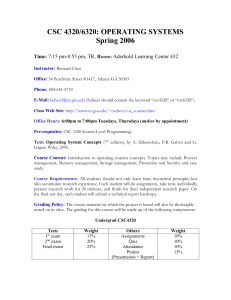URSI 100 - INTRODUCTION TO THE CITY Spring 2014 Instructor
advertisement
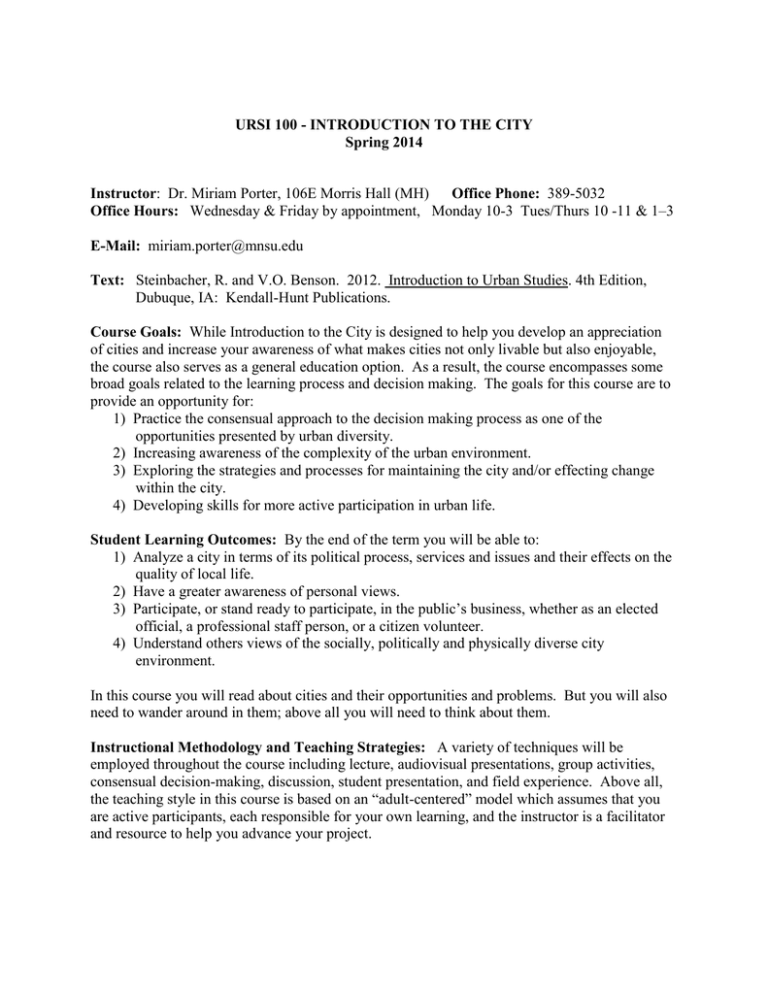
URSI 100 - INTRODUCTION TO THE CITY Spring 2014 Instructor: Dr. Miriam Porter, 106E Morris Hall (MH) Office Phone: 389-5032 Office Hours: Wednesday & Friday by appointment, Monday 10-3 Tues/Thurs 10 -11 & 1–3 E-Mail: miriam.porter@mnsu.edu Text: Steinbacher, R. and V.O. Benson. 2012. Introduction to Urban Studies. 4th Edition, Dubuque, IA: Kendall-Hunt Publications. Course Goals: While Introduction to the City is designed to help you develop an appreciation of cities and increase your awareness of what makes cities not only livable but also enjoyable, the course also serves as a general education option. As a result, the course encompasses some broad goals related to the learning process and decision making. The goals for this course are to provide an opportunity for: 1) Practice the consensual approach to the decision making process as one of the opportunities presented by urban diversity. 2) Increasing awareness of the complexity of the urban environment. 3) Exploring the strategies and processes for maintaining the city and/or effecting change within the city. 4) Developing skills for more active participation in urban life. Student Learning Outcomes: By the end of the term you will be able to: 1) Analyze a city in terms of its political process, services and issues and their effects on the quality of local life. 2) Have a greater awareness of personal views. 3) Participate, or stand ready to participate, in the public’s business, whether as an elected official, a professional staff person, or a citizen volunteer. 4) Understand others views of the socially, politically and physically diverse city environment. In this course you will read about cities and their opportunities and problems. But you will also need to wander around in them; above all you will need to think about them. Instructional Methodology and Teaching Strategies: A variety of techniques will be employed throughout the course including lecture, audiovisual presentations, group activities, consensual decision-making, discussion, student presentation, and field experience. Above all, the teaching style in this course is based on an “adult-centered” model which assumes that you are active participants, each responsible for your own learning, and the instructor is a facilitator and resource to help you advance your project. Assignments: 1) Classwork: You are expected to read the appropriate sections in the textbook prior to their due date. Assignments are required to be completed by the due date on the Course Guide. The class will be a mixture of problem-solving, class discussion, group work, and lecture. 2) “Vision of the City” Design Project: The class will culminate with the design and presentation of your vision of Mankato in 2065. Grades will be assigned both on the basis of group work and individual contribution to the group. You will rate the other members in your group on their individual contributions to the Vision of the City project. 3) Testing: There will be a Mid-term and a comprehensive Final test. Both tests may be a combination of true/false, multiple choice and/or essay questions. In all cases, the student will be expected to pick the best answer. 4) Projects: Generally, each class will involve some sort of activity; these activities will require a group written summary. The project summaries will be handed in with the signatures of each group member. 5) Group Work: An integral part of classroom instruction is group work. Students will be exposed to working in groups of other students to discern concepts, answer questions, and gain knowledge. Course Grading: Projects/Exercises Vision of the City 40% 25% Mid-term test Final test 15% 20% The final grade may be based on a curve. At the least, students may expect the 90%=A, 80%=B, 70%=C, 60%=D. Regardless of a curve a minimum of 60% must be obtained to earn a passing grade. Course Policies: 1) All assignments are due on the assigned date. There will be no make-ups except for very unusual circumstances. No extensions or make-ups are allowed without prior permission. 2) You may use any resource for your course-work, as long as you identify your sources. (Failure to do so is plagiarism and could result in an F for the course). Copying the work of a class-mate on tests will result in an F for the course. 3) Class attendance is strongly encouraged. Absences will result in loss of grade points. Every attempt will be made to accommodate qualified students with disabilities. If you are a student with a documented disability, please see me as early in the semester as possible to discuss the necessary accommodations, and/or contact the Disability Services Office at 507/3892825 (V) or 1-800-627-3529 (MRS/TTY). Other Policy: Please turn off cell phones and beepers during class time. Course Guide – Spring Semester 2014 This is a guide for class activities, due dates for assignments and readings. Changes may occur. If they do, you will be notified in advance of the changes and the adjusted responsibilities you incur. Key to Using Course Guide Week #: week of semester Class Date: Reading that is due by this date Workbook assignments that are due on this date to accomplish class or group activities Project List. Activities that you are required to prepare from the project list that are due on this date ______________________________________________________________________________ Week 1 Jan 14 Introductions; review course requirements Jan 16 Working in groups and consensual decision making Week 2 Jan 21 Jan 23 Week 3 Jan 28 Jan 30 Week 4 Feb 4 Feb 6 Reading: Chapter 1; Exercises (Exc.): 1.1, 1.4, 1.6; Project List: 1A (Begin work on 14.5) Movie: “Roman Cities” Career Day Panel Reading: Chapter 3; Exc: 3.2, 3.3; Discuss Field Day Exercises (Proj.list:1B & C) Project List: 2A and 2B Field Day – Project List: 1B & 1C Reading: Chapter 14 (Chp 15 pages 266-267 only related to Louis Wirth); Project List: 3A & 3B; Exc:14.1,14.2 and 14.5 Week 5 Feb 11 Feb 13 Movie: “Survival of a Small City” Reading: Chapter 10; Exc: 10.2A and 10.2B; Project List: 4A, 1B and C Continued for Discussion. Discuss Field Day Exercies (Proj. list 4:4B & 4C) Week 6 Feb 18 Feb 20 Field Day – Project List: 4B and 4C Reading: Chapter 9. Exc 9.1 Project List: 4B and 4C continued for discussion Week 7 Feb 25 Feb 27 Movie: “Back from the Brink” Reading: Chapter 4 and 5; Project List: 5A and 5B; Exc: 5.2 Week 8 Mar 4 Mar 6 Read Chapter 6; Project List 6A and 6B; Midterm Review; Mid-term test / Consultation with individual students Week 9 March 10-14 Spring Break Week 10 Mar 18 Mar 20 Reading: Chapter 7 and 8; Project List: 7A, 7B & 7C Project List: 8A Week 11 Mar 25 Mar 26 Reading: Chapter 12: Exc 12.1, 12.3 & 12.4 Project List: 8B and 8C Public life (in-class exercises) Week 12 Apr 1 Apr 3 Movie: “Understanding Prejudice” Reading: Chapter 15; Exc. 15.1, 15.2 Week 13 Apr 8 Apr 10 Movie: “The Laramie Project” Reading: Chapter 16; Exc: 16.2, 16.3 Group discussion on Diversity; Family Ancestry-Paper due Week 14 Apr 15 Apr 17 Reading: Chapters 2 and 11; EXC 2.3, 2.4, 11.2 and 11.4; final exam review Reading: Chapters 17 and 18; Exc: 18.1, and 18.2 (Project List 9 extra credit) Week 15 Apr 22 Apr 24 “Vision of the City” – project discussion Final Exam / Vision of City Preparation Week 16 April 29 May 1 Vision of the City Preparation Vision of the City Preparation Finals Week Vision of the City Presentation Thursday, May 8, 10:15-12:15 PM VISION OF THE CITY PROJECT Describe the consensus of your group of the ideal for Mankato in the year 2065 given the following assumptions: ---Assume the city will have grown to 75,000 people, spreading out toward Eagle Lake, Nicollet, Rapidan and Kasota. ---Assume the county population has remained stable--despite population growth in the city. ---Assume the growth in the economic base of the city is in health care, high-tech manufacturing, and retail. Higher education held at current levels. 1. Using information from the class, your field assignments, the library, and the local newspaper, develop your vision for the Mankato area for 2065. a. What factors/events/trends will contribute to the city by the year 2065? Include issues relating to the Environment, Business & Economics, Transportation, Education, and The Arts, Housing and Safety. b. Within these circumstances, what is ideal for Mankato in 2065? What is your Vision? c. What are the barriers to your vision? What forces will reinforce it? 2. Develop a plan for Mankato 2065--a. Write a scenario (story) which describes how the city grew from what it is today to what it has become in 2065. b. Diagram the location of all major activities/components of the city that are focal to your vision. c. Develop a 3-dimensional model of the most important elements of your plan. You could do this by modeling, say, a 10-block area where the most intensive activity will occur, or by portraying the whole city with only certain areas done in detail, or anything in between. d. In developing your plan, pay attention to the following issues: i) reflects current planning practice (as developed in class exercises); or, if you choose to modify current standards, explain why and how). ii) Reflects issues of --safety and security --design-with-nature --sound economic basis, for residents, for businesses, and for city --attractiveness, convenience, and cost --housing 3. Prepare a brief (3-minute) presentation to the class which describes your vision for the future of Mankato. URSI 100 Project List with Summary Directions Project List 1: Looking to See A. Describing a “setting” --A setting is a place which is characterized by a distinctive pattern of behavior --Select 3 settings off campus (each should be radically different from the other two) --Describe each setting, discussing both its physical features and social features. Describe each setting in enough detail that we can reconstruct the setting from your description alone, and be able to distinguish it from similar settings elsewhere in the city. B. Perception and awareness --Look at a map of the city (there’s one in the phone book), and find a knot of streets that you never knew were there. Walk (do not ride or drive) through that area for at least 10 minutes, making a note of every setting which captures your attention. Give a brief description of each one. --Review your list of settings. What was it about each one that captured your attention? --Develop a list of characteristics which, in your experience (from this experience) stimulate awareness of settings. C. Based on your work in the two previous exercises, classroom discussion and your reading and Workbook assignments, what have you learned about your approach to experiencing the city (compared to your classmates)? Provide specific evidence of • ways in which you are a “place” person • ways in which you are a “thing” person • ways in which you are a “people” person --What does this imply about the way you will learn best in this class? Project List 2: The City Design A. Identify and list similarities and differences between Roman cities and the community in which you are most familiar. What conclusion can you draw from your lists? B. Communities often demonstrate a design ethic. Give an example of a design ethic or some things that demonstrate your community’s values. Project List 3: The Experience of Living in Cities A. Perceived Space --Where do you feel fearful or uncomfortable? Where do you find relief from those feelings? With what type of people do you feel these different ways? List the characteristics of the places or situations which make you feel uncomfortable. B. The Experience of Living in the City Louis Wirth says that the experience of living in cities is characterized by large size, density, and diversity. Based on your work in the previous exercise, class discussion, and your reading and workbook assignments, demonstrate the correctness of Wirth’s position, or refute it and offer a better theory. Project List 4: The Structure of Cities A. Identify an example in Mankato of each of the following: --A service or facility for which there is: • only one outlet in Mankato • no more than 5 outlets in Mankato • about 30 outlets • more than 100 outlets --A place where: • everyone is a stranger • 15 people might meet • 500 people might meet • more than 1,000 people might meet • one person can be alone • no one goes --Locate these places on a map. What pattern is there to the distribution of these places? What does this suggest to you? B. Shopping regions: For the downtown shopping area, Old Town, River Hills Mall, and a neighborhood shopping area, survey the following details: • ownership of commercial establishments • quality and place of origin for goods in stores • residence of proprietors and salespeople • characteristics of people shopping (e.g., age, sex, ethnicity, social class) and how they traveled to the area • any special features of the area --On the basis of your observation, what are the similarities and differences in the functions served by each of these shopping areas? C. Messages: Survey a neighborhood in Mankato/N. Mankato. Describe indicators of local residents’ attitudes of: • satisfaction with the environment • dissatisfaction with the environment • community cohesion or conflict “Body language” is a way people communicate with each other--sometimes contradicting, sometimes confirming what is being said verbally. What does the “street language” of your neighborhood say? Project List 5: Making a Place A. Quality of Life: There are several systems which purport to rate the “quality of life” in cities (e.g. Rochester, MN, has been rated as one of the nation’s most livable cities; so has Mankato, in a different rating system). --What are your key criteria for rating the “quality of life” in a city? --Develop a method to measure each of your criteria (preferably using observable, quantitative measures) --Rate 5 cities on your QOL Scale. B. Fritz Steele (The Sense of Place, 1981) lists 8 criteria and 3 methods for “making places by influencing settings”: Criteria Methods Choices and options Creating new settings Reinforcing patterns and sequences Reworking existing settings Rich material for fantasy and memory Not unmaking places Sense of identity Highlighting personal awareness Highlighting opportunities Appropriate scale Active vitality Describe a new setting on campus for a function of your choice. Project List 6: Design for Living A. What if ... MSU received a generous gift from an “alum” including a gift of land and funds to initiate the development of a new housing complex just for MSU students. The land is the equivalent of approximately 4 blocks and is within walking distance of the campus. You are one of several developing design proposals for the new housing complex and related amenities. a) Describe anticipated residents of your complex (age, income, lifestyle, etc.). For the population identified, list their needs and wants as they relate to the housing complex. What design solutions will satisfy the needs and wants you identified? b) Develop a model of the 4-block area which includes your proposal design solutions. Include any additional written explanation needed to make the design concepts clear. Why is your design the best of all solutions for the student group you identified? B. How has Minnesota State University influenced the development of Mankato/North Mankato? Consider --MSU’s impact on city physical facilities --MSU’s economic impact --MSU’s social/cultural impact --MSU’s political impact Project List 7: Governing the City A. Power: Go into the city and find 10 “things” that represent power. Briefly describe each one. Based on your list, answer these questions: a. What is “power’? b. How do you get it? c. How do you keep it? d. How do you lose it? e. How do you use it? f. Who has it? B. Governing the City 1. Attend one of the public meetings (i.e., city council or planning commission meeting) of one of the units of local government in our area. 2. Arrive 1/2 hour before meeting begins. Sketch the room’s floor plan. --Walk to the front of the room: How are the chairs set up for the officials? How will they view the meeting room? How will they view those attending the meeting? --How are the chairs arranged for the general public? Are any provisions made for the public to address the meeting? How many people can the meeting hall contain? --Sit somewhere (to the back or to the side) where you can get a clear view of both the officials and the public. How may people come to the meeting? When do they arrive? Where do they sit? 3. Pay attention to the public meeting. --How many issues are raised at the meeting? What were the issues that were discussed? Of these, how many do the public officials consider important? How could you tell? Of these, how many do the public consider important? How could you tell? --How is the meeting run? How is order maintained? How is “power” demonstrated and used? How are issues decided? 4. Record your reflections on what you have seen: What is the “public” (formal) process of local governance? What is the “private” (informal) process of local governance? What clues to its existence could you find at the meeting you attended? Attach a sketch of the meeting room and the placement of all the participants. Attach the agenda from the meeting C. Governing the City How can “just an ordinary citizen” reasonably expect to have his/her voice heard at City Hall? --What must local government do so ordinary citizens can be heard? --What is the role of local groups in making ordinary citizens heard? --What must ordinary citizens do so their voice can be heard? Project List 8: Making the Hard Choices A. Miniapple City Council Game (Group Exercise--groups of 7) Instructions will be handed out in class. Reflection: What did you learn from this exercise? As you began the game, you brought certain assumptions about the best solution and the most likely way the game would proceed. -- What turned out the way you expected? Why? -- What turned out differently than you expected. Why? -- To what extent is the decision-making process (at least as exemplified in your class) a rational process? B. Poor Hannah’s Ice Cream Stand (Group Exercise-groups of 4). Read the attached article from the Reader’s Digest. --Is the situation described in this story reasonable? Is it fair? Is there a difference? --Who is at fault? (Is this a trick question? Is anyone at fault? Does someone have to be at fault whenever bad things happen?) --If you were in charge (made the rules) would you do things differently? C. Making Hard Choices 1) Does every problem have a solution? If yes, how do you find it? If no, what do you do in those cases? 2) What rules/criteria did you find yourself using when you had to make hard choices? List them. Then rank them in order, such that rule 1 must always be followed; rule 2 must be followed unless it violates rule 1; rule 3 must be followed unless it violates rule 1 or rule 2, etc. 3) What happens when your rules come in conflict with the rules held by others in your group/class/community? How do you handle it? Project List 9: Future of Cities A. Find a newspaper, magazine, or journal article on the future of cities. In a short paper summarize the article. Then provide your perspective on the merit of the article. Why do you agree or disagree with the author’s ideas?
